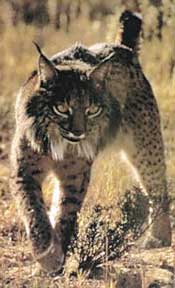 Two more Iberian Lynx cubs were born in captivity on March 23rd at 9:30pm to the same mother, Saliega, as last year's historic cubs - the first Iberian lynx to have ever been bred in captivity.
Two more Iberian Lynx cubs were born in captivity on March 23rd at 9:30pm to the same mother, Saliega, as last year's historic cubs - the first Iberian lynx to have ever been bred in captivity. This is a truly wonderful achievement, considering the fact that the species is now recognized as the most endangered feline in the world.
The cubs were born at El Acebuche lynx breeding facilities in Doñana, Spain. So far the sex is unknown. It is possible that another of the five captive females (Esperanza and/or Adelfa) may be pregnant and may give birth in the next few days. This cannot be confirmed as the lynx workers take a hands-off approach. Both lynxes have put on weight but this may be a psychological pregnancy. The Acebuche centre is considered too small and this spring a second centre is to open in La Aliseda in Jaen which will take the new cubs and new captures.
Saliega and her new cubs
The latest lynx count by the Junta de Andalucia estimates that at the end of 2005 there were a minimum of 38 females with territories, a basic unit for counting lynx populations - as in a male's territory there can be one or several breeding females. These female territories were divided between Sierra Morena (26) and Doñana (15), an increase of three over last years (all three in Sierra Morena), and the highest detected since 2001.
The minimum number of cubs confirmed (older than six months) is 36 (10 in Doñana and 26 in Sierra Morena.) The total population of the Iberian lynx, including this year's cubs is estimated at 169, up from 2001 with less than 140. The Sierra Morena population is now thought to be expanding, while Doñana is stagnant, though for the first time in three years a brood of lynxes have been born within the National Park's reserve proper, a sign perhaps that recently established rabbit pens are starting to work.
Captive-bred Lynxes are to be reintroduced in three new areas in the wild by 2009. It has also been announced that the cubs born in captivity are to be released in three initial areas: Sierra Norte (Sevilla) and Despeñaperros (Jaén) and Hornachuelos / Guadalmellato (Córdoba). The reintroduction will be carried out through “soft releases” in fenced areas of 15-20 hectares which will later be opened up.
Extremadura, Castilla-La Mancha and Portugal have been asked to determine possible areas for reintroduction over the next few years, Undoubtedly the role of the lynx as a flagship species will be a spur for conservation in all these areas.
Read more about the amazing work of the El Acebuche lynx breeding facility (and photos of last year's cubs!) at Shadows and Light: Leopards, my discussion group on the Care2 network.

No comments:
Post a Comment